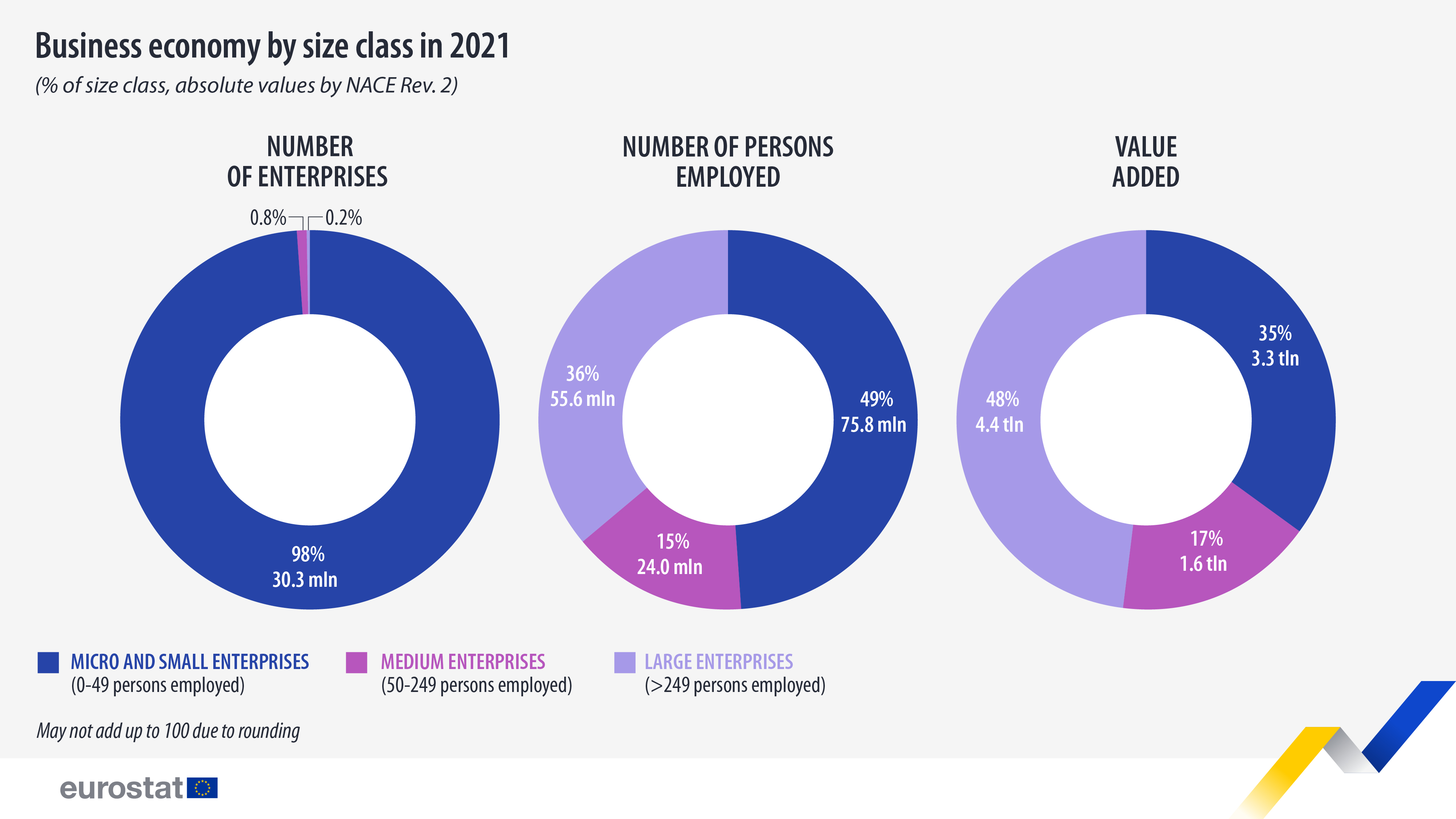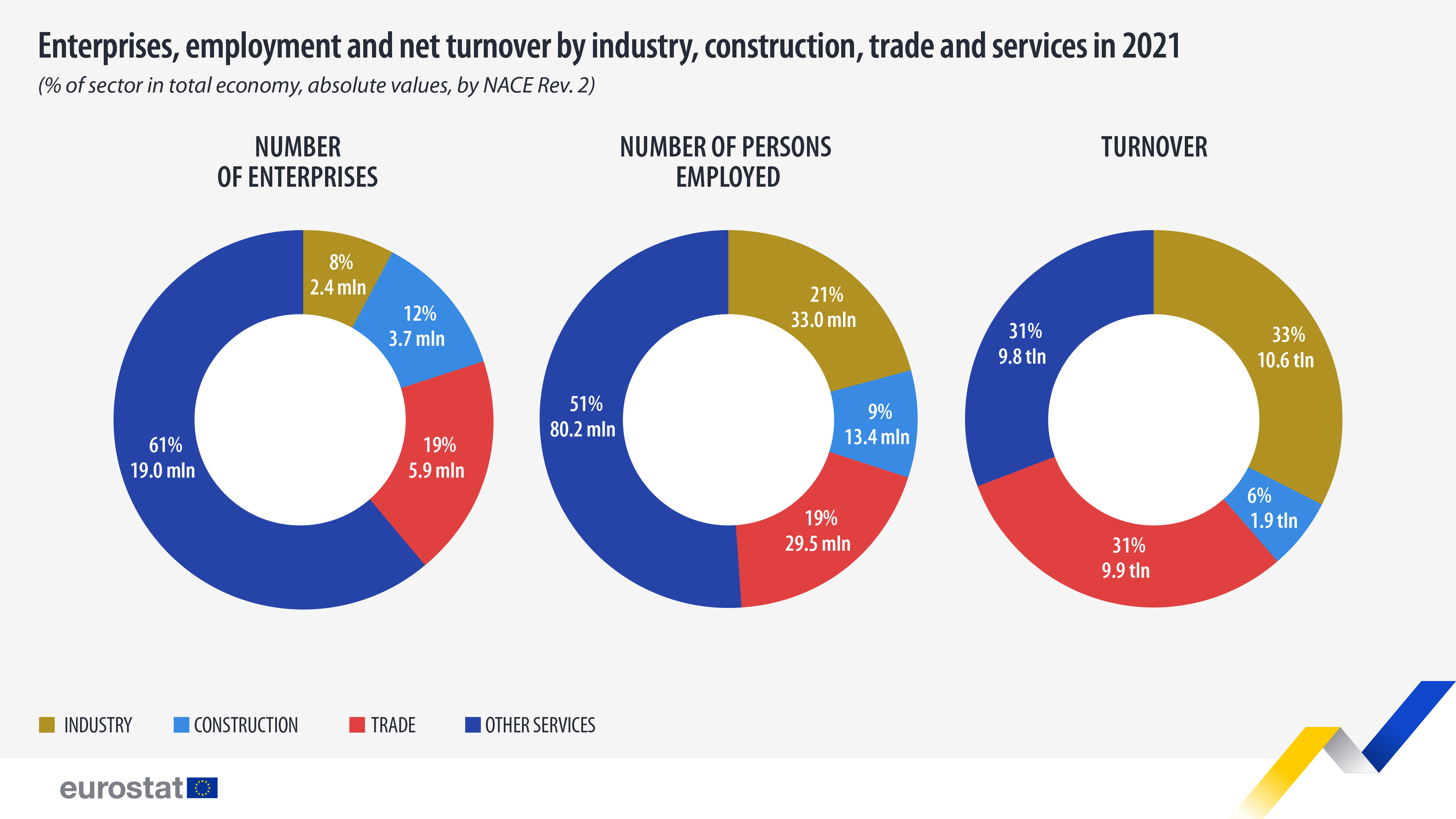2021: EU micro & small businesses employed 75.8 million
In 2021, the EU had 31 million enterprises, employing 156 million persons. Of that total, 98% (30.3 million) were micro and small enterprises with each employing up to 49 persons. Together micro and small enterprises employed 75.8 million persons, i.e., 49% of the total number of all persons employed in enterprises. They generated €3.3 trillion in value added, representing 35% of the total value added (€9.3 trillion).
The 240 000 medium-sized enterprises (50-249 persons employed) represented 0.8% of all enterprises and employed 24.0 million persons, registering a value added of €1.6 trillion (17%).
Even though large enterprises (more than 249 persons employed) represented only 0.2% of the total number of enterprises, they employed more than a third of the business labour force (55.6 million, 36%) and generated almost half (48%) of the value added (€4.4 trillion).
Eurostat publishes, for the first time, detailed Structural Business Statistics (SBS) that have been compiled along the requirements of the new framework for European Business Statistics (EBS). Several improvements enhance the data’s capacity for analysis of the enterprise sector in the EU. SBS now cover more variables and economic activities, e.g., activities within services (education; human health and social work activities; arts, entertainment and recreation) and financial and insurance activities. A more efficient presentation of SBS in Eurostat’s database ‘Eurobase’ facilitates comparisons between different parts of the economy and different EU countries.
In December 2022, Eurostat published preliminary data on SBS for 2021, for the first time by size classes of enterprises, for three variables (number of enterprises, employment, turnover).
Source dataset: sbs_sc_ovw
Industry: biggest turnover with only 8% of the companies
According to the data, the ‘industry’ sector was the one with the biggest turnover in 2021. It generated one-third of the turnover (€10.6 trillion, 33%) and employed around one-fifth of the business labour force (33.0 million persons, 21%). However, in the number of enterprises, it was the smallest sector with only 8% (2.4 million) of the total number of enterprises.
With 5.9 million enterprises, the ‘trade’ sector represented 19% of the total number. The 29.5 million persons employed there generated 31% (€9.9 trillion) of the total turnover.
The ‘construction’ sector represented 12% of the total number of enterprises but only 6% (€1.9 trillion) of the total turnover. This sector had 13.4 million persons employed.
The ‘other services’, including companies working in a variety of services from ‘transportation and storage’ to ‘accommodation and food service activities’, ‘education’, ‘human health and social work activities’ and ‘arts, entertainment and recreation’, account for the highest number of companies, 61% of the total (19.0 million enterprises). And although these enterprises employed almost half the persons (80.2 million, 51%), the turnover was less than one-third (€9.8 trillion, 31%).
Source dataset: sbs_sc_ovw
For more information
- Statistics Explained article on European Business Statistics
- Database on structural business statistics
- Thematic section on structural business statistics
Methodological notes
- Economic activities as described by the NACE Rev. 2 classification.
- The term ‘Business economy’ is defined as industry, construction and market services (except public administration and defence; compulsory social security; activities of membership organisations).
- Micro, small, medium-sized and large enterprises in SBS are defined on the basis of the number of persons employed only and do not take into account other factors such as turnover and balance sheet total and could belong to a larger enterprise group.
- Number of persons employed is the number of employees and self-employed persons.
If you have any queries, please visit our contact us page.


